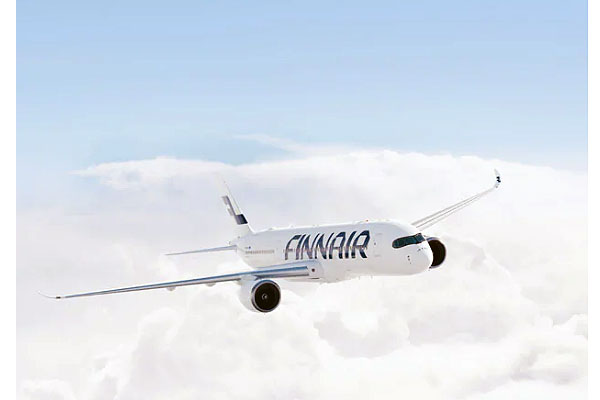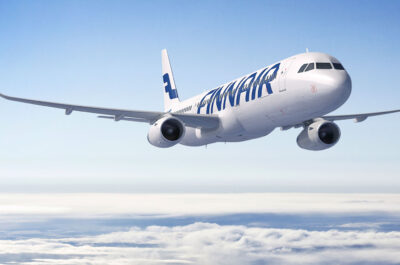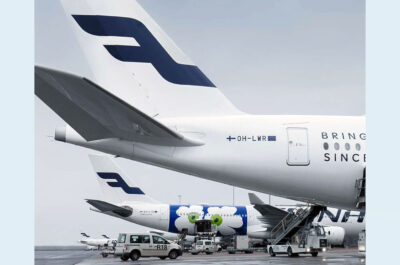Finnair has ordered a total of 19 new A350-900 XWB aircraft from Airbus, of which 16 have been delivered as of September 1, 2020
As a part of Finnair’s rebuild program, the company has finalised a lease financing arrangement for its next A350 aircraft delivery, with JLPS Holding Ireland Limited as the lessor and lease servicer. In the arrangement, Finnair will assign the purchase of the Airbus A350 aircraft to a third party, and then leases it back for its own operation. The aircraft is expected to be delivered to Finnair in the second quarter of 2022. The operating lease period is a minimum of 12 years, including a storage period expected to commence in the fourth quarter of 2021, concurrent with the aircraft‘s sale.
The total positive cash effect of the arrangement for Finnair in 2021–2022 is in excess of 100 million US dollars compared to a situation in which the aircraft had been purchased and owned by Finnair.
Finnair has ordered a total of 19 new A350-900 XWB aircraft from Airbus, of which 16 have been delivered as of September 1, 2020; the aircraft concerned will be the 17th. The remaining two A350 aircraft are expected to be delivered in the fourth quarter of 2024 and the first quarter of 2025.
Finnair joins forces with air navigation service provider Fintraffic ANS to lower CO2 emissions
Also, Finnair and Finland’s air navigation service provider Fintraffic ANS have joined forces to reduce CO2 emissions and enhance commercial aviation’s environmental footprint.
Under the new initiative, Finnair will share fuel consumption data with Fintraffic ANS and the parties will together explore how to support airlines in their bid to drive down and meet new lower emissions targets.
As part of its industry-leading commitment to sustainability, Finnair is committed to halving its net CO2 emissions by the end of 2025 and achieving carbon neutrality in 2045.
Finnair pilot, Captain Tom Hakala, is in charge of fuel efficiency of Finnair flight operations and advises how Finnair pilots can maximise their fuel-efficient flying techniques.
Captain Hakala said: “Reducing the CO2 emissions of our flight operations is our number one environmental target, and we work for this on every single flight.
“Through this welcome partnership, we will now start sharing openly our fuel data and the impact air navigation services’ actions have on fuel consumption. Together with Fintraffic ANS we can explore new ways of further reducing the amount of fuel we use and the environmental impact of flying upon the environment."
“Our vision is that Finland has the safest, smoothest and most environmentally friendly airspace in the world. Every day, we focus on making air traffic as optimized as possible. Flight route optimization, continuous descent approach and close international cooperation are our means of reducing emissions”, says Pasi Nikama, Fintraffic ANS CCO.
“Air navigation services must also take into account the requirements of the environmental permit for aircraft noise management. Close cooperation with Finnair gives us new information and ways to develop Finnish air traffic to be even more environmentally efficient”.
Reducing a flight’s fuel consumption starts by planning the route to be as efficient as possible. During the flight, measures include minimising time and unnecessary stops in taxiing, using continuous climb and descent during take-off and landing. Other considerations include optimizing the flight route, speed and altitude taking into account the weather conditions. In Finland, the airspace can be very efficiently used, which was also highlighted by Eurocontrol’s study last year.
In November 2020, Finnair and Fintraffic ANS explored the possibilities for minimising fuel consumption with two test flights flown from Helsinki to Kittila and Ivalo.
On the test flights, the flight time, flight length, fuel consumption and CO2 emissions were measured, and data comparison was made between the optimal plan and the realized flight. The flights showed several factors, such as weather conditions and other air space users, affected the possibility to optimize fuel consumption.
”Fuel efficiency is impacted by many factors, and even small actions make a difference, when they are repeated on thousands of flights per year”, says Tom Hakala.
On Wednesday 17 February Finnair will fly from Helsinki to Kittila in Northern Finland, and the different phases of the flight and their impact on fuel consumption are followed on Finnair’s Instagram and Twitter accounts.
Anne Larilahti, Finnair Vice President of Sustainability said: ”This flight also uses sustainable aviation fuel (SAF) – with book and claim principle – purchased by our customers.”
”In the next phase of our SAF use, through our partnership with Finnish sustainable fuel provider Neste, will enable us to use SAF at our home hub in Helsinki Airport.”
Fuel efficiency is key for Finnair to reach its ambitious CO2 reduction targets. Finnair improves fuel efficiency by operating an efficient fleet, reducing aircraft weight, flying more fuel efficiently and by collaborating with different stakeholders across industries. Sustainable aviation fuels and carbon offsets are also needed to reach Finnair’s CO2 reduction targets.
Vicky is the co-founder of TravelDailyNews Media Network where she is the Editor-in Chief. She is also responsible for the daily operation and the financial policy. She holds a Bachelor's degree in Tourism Business Administration from the Technical University of Athens and a Master in Business Administration (MBA) from the University of Wales.
She has many years of both academic and industrial experience within the travel industry. She has written/edited numerous articles in various tourism magazines.































































































































































































































